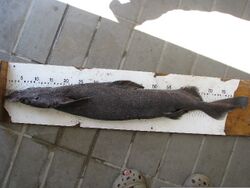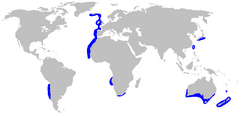Biology:Birdbeak dogfish
| Birdbeak dogfish | |
|---|---|

| |
| Drawing by Bideault | |

| |
| Scientific classification | |
| Domain: | Eukaryota |
| Kingdom: | Animalia |
| Phylum: | Chordata |
| Class: | Chondrichthyes |
| Subclass: | Elasmobranchii |
| Subdivision: | Selachimorpha |
| Order: | Squaliformes |
| Family: | Centrophoridae |
| Genus: | Deania |
| Species: | D. calcea
|
| Binomial name | |
| Deania calcea (R. T. Lowe, 1839)
| |

| |
| Range of birdbeak dogfish (in blue) | |
The birdbeak dogfish (Deania calcea) is a dogfish shark of the family Centrophoridae found in the Pacific Ocean around Honshū, Japan , southern Australia , New Zealand, and Chile , and in the Atlantic Ocean from Iceland south to the Cape of Good Hope.[2]
The birdbeak dogfish has a very long, narrow snout, no anal fin, two long and low dorsal fins with grooved spines, small rectangular pectoral fins, and pitchfork-like denticles. It lives at depths between 73 and 1,450 m. It is ovoviviparous with up to 12 pups per litter. It eats bony fish and shrimp.[2]
In June 2018 the New Zealand Department of Conservation classified the birdbeak dogfish as "Not Threatened" under the New Zealand Threat Classification System.[3]
A study published in the Journal of the Marine Biological Association of the United Kingdom evaluated the reproductive strategy of the female deep-water shark birdbeak dogfish. This research article discovers that there is a close relationship that exists between Hg level of pregnant females and the Hg level of their embryos, which indicates that there is a transfer of mercury from maternal sources. Therefore, there is a matrophoric strategy for the birdbeak dogfish that are ovoviviparous.[4]
With the rise of fisheries, the birdbeak dogfish is being consumed at higher rates. It has been found to be a good source of minerals, such as potassium and sodium. However, there have been health risks associated with frequent consumption of female dogfish.[5]
References
- ↑ Finucci, B.; Cheok, J.; Cotton, C.F.; Kulka, D.W.; Neat, F.C.; Pacoureau, N.; Rigby, C.L.; Tanaka, S. et al. (2020). "Deania calcea". IUCN Red List of Threatened Species 2020: e.T41798A68619155. doi:10.2305/IUCN.UK.2020-3.RLTS.T41798A68619155.en. https://www.iucnredlist.org/species/41798/68619155. Retrieved 19 November 2021.
- ↑ Jump up to: 2.0 2.1 Carpenter, Kent E.; Luna, Susan M. (2019). "Deania calcea (Lowe, 1839) Birdbeak dogfish". http://www.fishbase.se/summary/Deania-calcea.html.
- ↑ Duffy, Clinton A. J.; Francis, Malcolm; Dunn, M. R.; Finucci, Brit; Ford, Richard; Hitchmough, Rod; Rolfe, Jeremy (2018). Conservation status of New Zealand chondrichthyans (chimaeras, sharks and rays), 2016. Wellington, New Zealand: Department of Conservation. pp. 10. ISBN 9781988514628. OCLC 1042901090. https://www.doc.govt.nz/globalassets/documents/science-and-technical/nztcs23entire.pdf.
- ↑ Paiva, R., Neves, A., Sequeira, V., Nunes, M., Gordo, L., & Bandarra, N. (2012). "Reproductive strategy of the female deep-water shark birdbeak dogfish, Deania calcea: Lecithotrophy or matrotrophy?" Journal of the Marine Biological Association of the United Kingdom, 92(2), 387-394. doi:10.1017/S0025315411001743
- ↑ Barros Paiva, Rafaela; Neves, Ana; Sequeira, Vera; Cardoso, Carlos; Bandarra, Narcisa; Serrano Gordo, Leonel; Leonor Nunes, Maria (2012-06-08). "Risks and benefits' consumption of birdbeak dogfish Deania calcea" (in en). British Food Journal 114 (6): 826–839. doi:10.1108/00070701211234354. ISSN 0007-070X. https://www.emerald.com/insight/content/doi/10.1108/00070701211234354/full/html.
Wikidata ☰ Q667012 entry
 |


